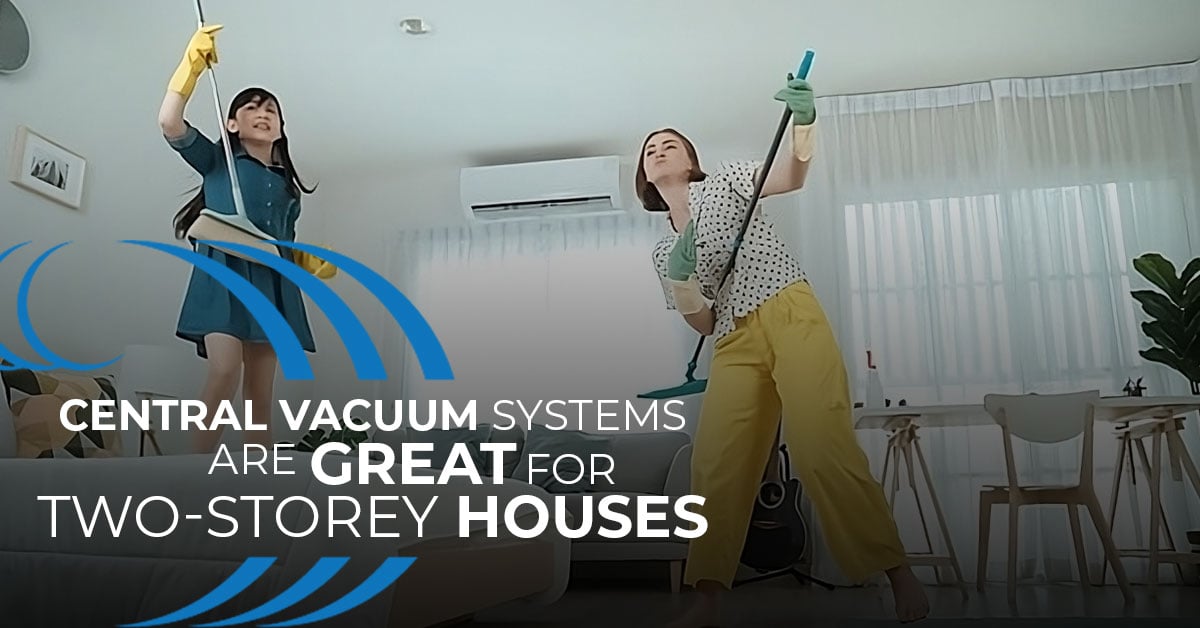
Boosting Productivity in Office Buildings with Central Vacuum
In today’s fast-paced work environment, maintaining a clean and organized office space is crucial for productivity. Office buildings often struggle with keeping their premises clean

Vacuuming isn’t always fun, especially when it’s being done in a two-storey house that makes you carry a heavy vacuum up and down the stairs.
Good thing central vacuum systems were made to eliminate that burden, allowing you to easily and comfortably clean your home with just a lightweight hose and some vacuum attachments.
However, some people will tell you that the installation is too expensive and that it’s better to buy a few conventional vacuums for each floor than to have a central vacuum system installed in your home.
It’s true that central vacuum systems are more expensive than standard vacuums. But with the convenience and performance that central vacuum systems provide, they are much superior to standard vacuums in so many ways and are always worth installing in multiple-story homes.
Unlike a standard vacuum, a central vacuum system will provide you with a ton of other benefits besides simplifying your cleaning routine.
Here are good reasons why a central vacuum system is better than a conventional vacuum:
Compared to a portable or upright vacuum cleaner that needs to be lugged around, a central vacuum system is already built throughout your house, so you don’t need to hold anything that’s fatiguing to your hand while you’re vacuuming.
You only need vacuum accessories and a cleaning hose that you will plug into a wall inlet to start the power unit or suction motor.
Through plastic pipes and low-voltage wiring that are usually installed inside walls, the wall inlets are connected to the power unit that is located in the garage or basement. Dirt and debris travel through the pipes as they are suctioned and stored by the power unit.
A central vacuum system is also versatile enough to let you clean surfaces and crevices that are hard to reach. Its cleaning hose is 30 in length, so it allows you to clean every corner of a room very easily.
To dust the tops of cabinets or shelves, you just need to climb and hold onto the ladder while holding the hose and brush with your other hand.
A Home Wave Central Vacuum System is five times more powerful than a regular vacuum.
Due to its stronger suction, it deeply cleans carpets by removing deep grit and particles that hasten the age of carpets.
Using a central vacuum is also recommended for asthma and allergy sufferers since it improves indoor air quality. It captures allergens and pet dander and deposits them into the dirt receptacle, making it difficult for the collected particles to re-enter your home.
Unlike a regular vacuum, no dust is returned into the rooms, and there is no pet odor coming from the exhaust.
Traditional vacuums have the tendency to stir up dust and dirt because they are being moved back and forth to different parts of the house.
Since the power unit of a central vacuum typically stays in a garage or basement, it is kept significantly cooler, which increases its longevity compared to portable vacuums.
The lifespan of your central vacuum system can range from 20 to 30 years, depending on how well you take care of it.
A standard vacuum, on the other hand, needs to be replaced every eight years.
A Home Wave Central Vacuum System provides higher suction force and more efficient cleaning without the use of any additional energy.
Just like a conventional vacuum cleaner, it uses a standard 120V socket even if it has a bigger and more powerful suction motor.
A high-quality central vacuum enables you to complete cleaning much more quickly than a standard vacuum would because of its suction strength and cleaning performance.
A central vacuum system doesn’t produce the same amount of noise that a typical vacuum does.
The suction motor is often located in a more remote area of the house, such as the garage or basement, so the only sounds you’ll hear from a central vacuum are the sounds of air passing through the pipes and the suction head itself.
Most central vacuum systems only produce noise at a maximum level of 60 decibels, or around the volume of two people speaking normally.
Thinking of adding a central vacuum system to your home?
You can build a central vacuum system on your own as long as you plan the layout carefully and you have all the tools that are needed.
It’s also a good idea to plan and coordinate with a professional to ensure that the process will be done smoothly and successfully.
Here are some tips for installing a central vacuum system, whether it’d be on a new construction or an existing home.
The first thing that you should do is to plan the location for the vacuum inlets.
The inlets should be strategically placed in your home. This is to avoid difficulties with the installation and prevent air leaks from happening in the pipes, as they can affect the system’s suction and overall efficiency.
Inlet valves are commonly installed in wall cavities, but they can also be installed in floors as long as they have metal covers. Make sure that the inlet locations will allow the cleaning hose to reach every corner of the house. It’s best to keep the number of inlets to a bare minimum.
For single-story houses, the PVC vacuum pipeline can run horizontally through a crawl space, basement or an attic and branch out in a short distance through interior walls or floors to connect with the inlets.
The same methods can be used in two-story homes. However, the installation can get tricky in two-story houses, so it’s better to get a technician who can do it right.
Next, install the power unit in the garage, basement, storage or utility room. We highly recommend installing the unit in the basement or lowest level of your home to avoid working against gravity. Dust and solids will fall more easily than if they were pulled upwards.
Also, avoid placing the unit in heated places as the motor needs good ventilation in order to last long and operate smoothly.
If you want an exhaust vent for your central vacuum, mount the power unit on an exterior wall.
Make sure the power unit is close to an outlet that provides sufficient power to run the system.
If you need more information on how to correctly install a power unit, contact your local dealer or check your central vacuum’s manual.
The difficulty of this procedure will depend on what type of home you have and whether it’s being constructed or already built.
It’s always easier to install pipes or inlets during the construction process.
For existing homes, inlet valves are easier to retrofit when they are installed in the floor. However, for two-story homes, the piping that connects to floor valves can be visible throughout the house. So to hide the pipes, you can take advantage of your closet or cabinets.
If you have an existing home, having access to a crawl space or an attic makes things easier for the installation.
Though installing the pipes should be relatively easy, you might find it a challenge to drill and cut holes through studs and framework.

In today’s fast-paced work environment, maintaining a clean and organized office space is crucial for productivity. Office buildings often struggle with keeping their premises clean

Central vacuums in animal shelters & vet clinic: Explore how these systems boost hygiene, efficiency, and air quality.

In the world of home entertainment, a home theater is a luxury that many homeowners dream of. It’s an immersive experience that brings the magic

A central vacuum system is a significant investment that promises convenience, powerful suction, and improved indoor air quality. However, choosing the right central vacuum hose
Our home automation products are at the forefront of technology, offering a blend of convenience, security, and efficiency. As a Homewave dealer, you’ll be part of a network transforming homes into smart, futuristic spaces.
Embark on this rewarding journey with us and leverage the power of innovative technology.
Please fill out this form and become a Homewave Dealer.